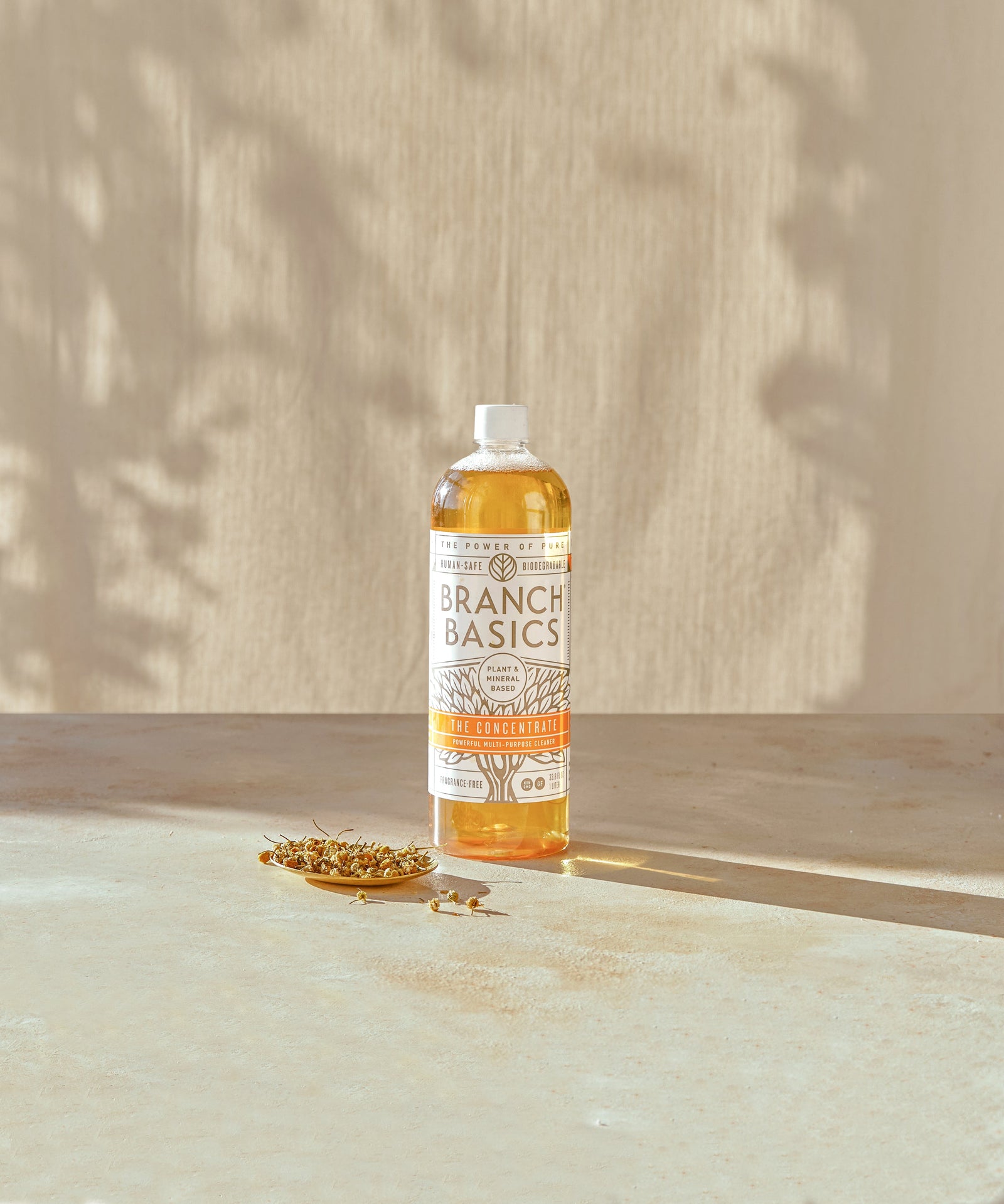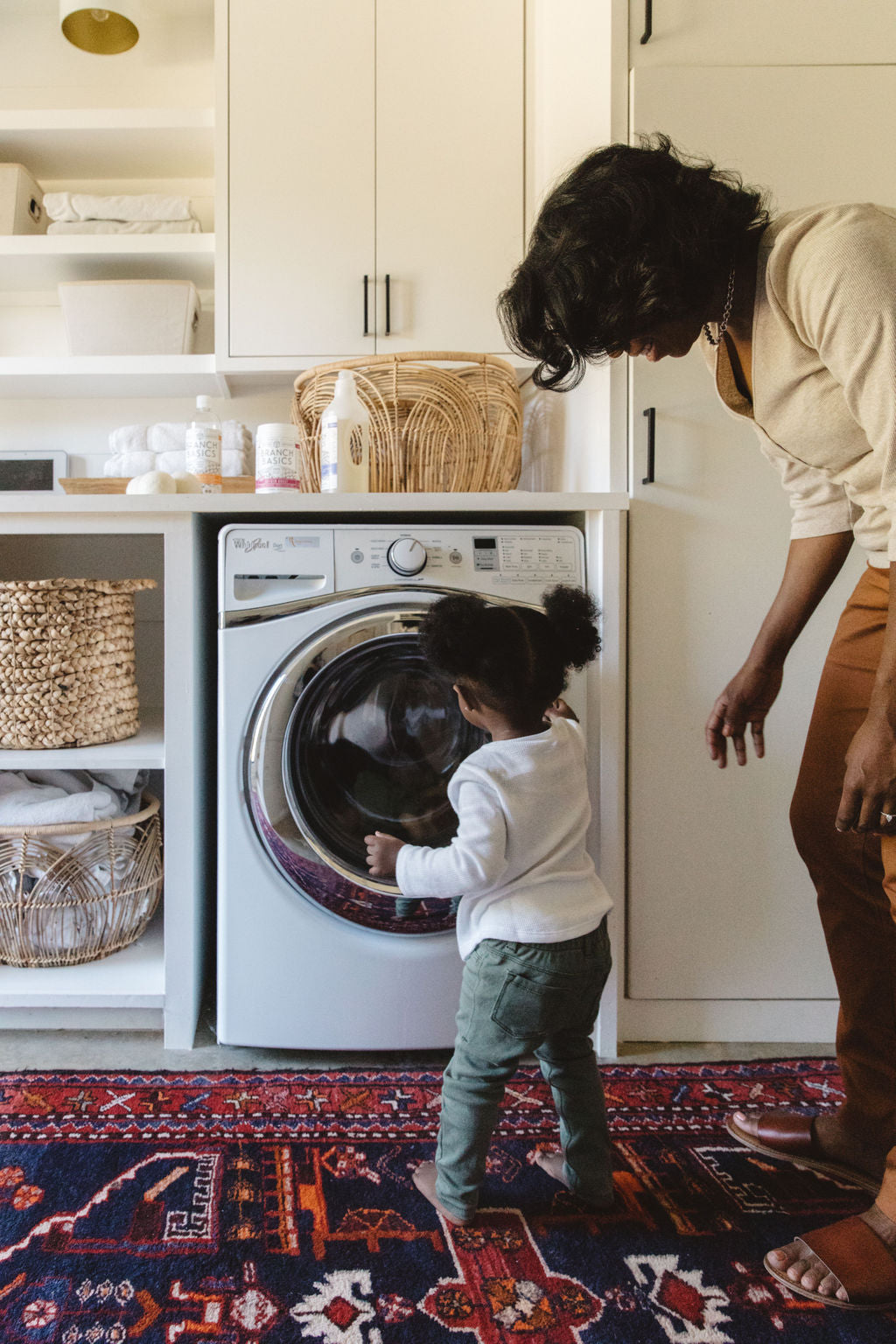How to Clean Textured Walls: 4 Simple and Natural Steps

Textured walls can create a nice contrast in a home.
However, cleaning them requires special care so as not to disturb or flake away the textured surface.
Generally, we recommend cleaning your walls at least once a year to remove built-up dust, particulates, pollens, etc.
And textured walls, with their many divots, textures, and crevices, can easily trap these indoor pollutants, making annual cleaning essential.
Fortunately, you don’t need expensive, synthetic-chemical-based cleaners or to hire a professional cleaning service.
Here, we’ll share how to clean textured walls naturally using simple, safe cleaning products and techniques that won’t damage your walls.
What You'll Need
The materials needed for cleaning textured walls are minimal.
Our cleaning procedure features Branch Basics Concentrate. You can also use a mild, human-safe, fragrance-free dish soap or liquid castile soap and water.
What you'll need on hand:
- A certified sealed HEPA vacuum for dusting OR microfiber duster or lint roller
- Branch Basics Concentrate
- Filtered or distilled water
- Two buckets
- A microfiber or sponge mop or microfiber cloth
Related read: The Best Human-Safe Deep Cleaning Checklist For Your Home
Step by Step: How to Clean Textured Walls (the Human-Safe Way)
Note that this procedure takes time and shouldn’t be rushed, especially with more delicately textured walls. We recommend queueing up your favorite podcast or playlist and using this time to relax and unwind.
You can also break up the task by working on one room at a time over days or weeks.
It doesn’t take much time to get set up, and this can make the task more manageable.
It can also be fun to clean with a friend or group of friends, your spouse or partner, or older children to make the job go by much more quickly. The promise of a fun activity, a healthy treat, or returning the favor by helping a friend clean their walls incentivizes helpers.
1. Spot Test Your Cleaner
Even very mild cleaners, like Branch Basics and other safe all-purpose cleaners, should be spot-tested to ensure compatibility with your textured walls.
To do this:
- Dip your cloth into the cleaning solution and dab it on an inconspicuous part of the wall, such as behind a door or curtain.
- Wipe off the cleaner with clean water.
- Dry with a towel or cloth and check for any discoloration.
- If it looks good, you’re good to go!
- If you notice discoloration, reduce the amount of Branch Basics Concentrate by ⅛ of a teaspoon and test again until you dial in the correct amount for your walls.
2: HEPA Vacuum The Wall Using The Brush Attachment OR Dust With These Tools
Dusting textured walls, which tend to get very dusty, is essential before applying the cleaning solution.
If you skip this step, the cleaning solution will move the dust around, resulting in a build-up of dust, cobwebs, etc., in hard-to-reach crevices and divots.
Since textured walls can harbor months (or years) of dust and contaminants, we only recommend using a certified-sealed HEPA vacuum for this task.
Unfortunately, non-HEPA vacuums can recirculate these particulates into the air, degrading indoor air quality.
Don’t worry, if you do not have a HEPA vacuum; a Swiffer Sweeper with unscented Swiffer cloths is perfect and easy to use! Watch this video demonstration.
- How to use a Swiffer to dust walls: Start with the ceiling and move down to walls, overlapping strokes by 30%. Since dust will be dislodged during this process, the order is important as the dust drops down on room surfaces from the ceiling
How to HEPA Vacuum Textured Walls
- Affix a brush attachment to your HEPA vacuum.
- Starting with the ceiling and moving down to walls, HEPA vacuum making three passes over each section, overlapping strokes by 30%.
- Going from top to bottom is vital as dust drops down on room surfaces from the walls.
- If you have children helping you, we recommend that the adult vacuum.
- Next, vacuum baseboards.
- Finally, vacuum the floors to ensure you pick up any excess dust or dirt.
- Take a deep breath! You’ve just dramatically improved your indoor air quality with this step alone.
3: Gently Wipe Down Walls With Branch Basics Solution
Now it's time for deep cleaning. Let's get into it!
To start, prepare two buckets, one with a cleaning solution and one for rinsing.
- Bucket #1: The Cleaning Solution Bucket
- 1 gallon of filtered or distilled water, room temperature + 1 teaspoon Branch Basics Concentrate.
- If you’re using safe dish soap or fragrance-free liquid castile soap, the general recommendation is 1/4 cup of soap with 1 gallon of water. (Test on surface for compatibility)
- We recommend filtered or distilled water to avoid the risk of hard water stains or mineral deposit residue on walls.
- Bucket #2: The Rinse Bucket
- Fill with clean distilled or filtered water at room temperature.
Next, start deep cleaning your textured walls (the human-safe way):
If you have a delicate, raised-textured surface, hand wiping with a microfiber cloth may be needed. This gives you more control and minimizes the chance of damaging the wall. However, many textured walls hold up well to a sponge mop or Swiffer microfiber mop. Test your surface.
If you have a flat textured surface, applying a mop gently will save some time and effort.
- Dip your microfiber cloth or microfiber or sponge mop in the Branch Basics solution. Squeeze thoroughly.
- Moving from the top of the wall to the baseboards, gently wipe over the wall.
- It’s OK for the surface to look slightly damp after wiping, but not wet.
- If it looks wet, squeeze more water out of the cleaning tool.
- As you require more cleaning solution, dip the cloth into the fresh water bucket first and squeeze to remove the soiled solution before re-dipping it in the Branch Basics bucket.
- Repeat this process three times on each section of the wall.
- Refill the clean water bucket with fresh water as the water becomes gray or soiled.
If the walls look too wet, dry using a large towel or microfiber cloths. Otherwise, move into the next step.
4. Let The Wall Air Dry
Let the walls air dry. Open the windows, if possible, to help. This completes the process.
Textured Wall Cleaning FAQs
We know cleaning textured walls can be nerve-racking, especially if it’s your first time. To help, we’re answering some FAQs.
What Should I Not Use On Textured Walls?
Textured walls should not be cleaned with harsh cleaners or abrasive cleaning tools, like scouring pads or vacuum attachments with rollers.
The best solution is to use the materials and products listed above and apply them gently.
How Do I Avoid Removing Paint On My Walls?
You can avoid removing paint and texture from your walls by:
- Avoid using harsh chemicals or synthetic soaps.
- Use a very dilute solution of soap to water.
- Do a patch test to ensure your walls can handle the cleaning solution.
- Following the procedure above, using very gentle strokes.
- Not over-saturating the walls. Wring the cloth, sponge, or mop very well and ensure the walls are damp, not soaking wet.
- If the walls become too wet, dry them gently with a towel or microfiber cloth.
Consider a Vodka Wipe Down of the Walls to Remove Embedded VOCs
Sometimes fragrances and VOCs from products used in the home can be incorporated into porous surfaces, especially drywall.
Inexpensive, unflavored vodka is a wonderful degreaser as well as a deodorizer for your walls. We recommend using vodka over vinegar, which is also a degreaser and deodorizer. Vodka is odorless and there are no cautions with its use! Vinegar, on the other hand, contains acetic acid which is a lung irritant.
- Use 1 part distilled water to 1 part vodka.
- Test on an inconspicuous area to verify compatibility with the solution.
- Dampen your microfiber or mop with the vodka solution. Make sure it's just damp, not saturated!
- Starting with the ceiling, dip your microfiber or mop in the solution and make 3 passes over each area.
- Continue with walls, wiping from top to bottom.
- No need to rinse the vodka off. It will evaporate and dry quickly.
Related read: How To Get Rid Of Musty Smells Naturally
Are Magic Erasers Safe On Painted Walls?
We do not recommend Magic Erasers because they contain potentially harmful cleaning chemicals.
Plus, their abrasive nature makes them incompatible with textured, wood, unfinished and painted walls with glossy paint.
They can be used on non-glossy painted walls, but always do a patch test first.
A safer alternative for spot cleaning is to make a baking soda paste with baking soda and water and apply it gently with a microfiber cloth.
3% hydrogen peroxide can also be used for stains and scuffs. Rub on gently and remove promptly. Remember to test first in an inconspicuous area.
Related read: Cleaning With Baking Soda (Sodium Bicarbonate): 12 Surprising Uses.
Toss the Toxins With Branch Basics
Whether you love them or are just putting up with them until you can renovate, textured walls aren’t difficult to clean using safe products.
If this article has inspired you to rethink your cleaning routine, we invite you to explore more of Branch Basics products and educational resources!
Our human-safe and natural cleaning line was designed to replace every single cleaning and laundry product in your home with just one Concentrate.
When you order a Branch Basics Premium Starter Kit (available in reusable plastic or glass), you’ll receive the Concentrate, Oxygen Boost, and five bottles to make your own All-Purpose, Bathroom, Streak-Free, Laundry, and Foaming Wash.
This gives you everything you need to clean your entire home and do your laundry—plus washing your car, walls and ceilings, hands, toys, and so much more—naturally and without toxic chemicals.
We also offer additional healthy products, including:
- Plastic-free and PVA-free Dishwashing Tablets
- Our best-selling Oxygen Boost (bleach alternative, laundry booster, soaking agent, stain remover, scouring agent, and more)
- Healthy & nourishing Gel Hand Soap
To learn more about what’s in Branch Basics and how it works, see:

Marilee Nelson
Marilee Nelson is an Environmental Toxins expert who has spent nearly 30 years advocating for the chemically-sensitive and chronically-ill. She is a Board Certified Nutritionist, Certified Bau-Biologist and Bau-Biology Inspector and specializes in Food As Medicine. She has helped thousands of families and individuals identify, heal and recover from toxic exposures and is on a mission to revolutionize the way American families view their health.








